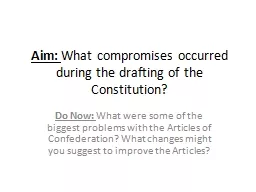

What compromises occurred during the drafting of the Constitution Do Now What were some of the biggest problems with the Articles of Confederation What changes might you suggest to improve the Articles ID: 244473
Download Presentation The PPT/PDF document "Aim:" is the property of its rightful owner. Permission is granted to download and print the materials on this web site for personal, non-commercial use only, and to display it on your personal computer provided you do not modify the materials and that you retain all copyright notices contained in the materials. By downloading content from our website, you accept the terms of this agreement.
Slide1
Aim: What compromises occurred during the drafting of the Constitution?
Do Now:
What were some of the biggest problems with the Articles of Confederation? What changes might you suggest to improve the Articles?Slide2
The Need for a New Government
With the Revolutionary war won, the individual states soon came into conflict with one another over trade and land rights
Without a strong national government, it seemed as if the country would soon tear itself apart
In September, 1786, delegates from five states met at the Annapolis Convention in Maryland and decided on the need for a Constitutional Convention to fix or replace the Articles of Confederation.
What states do you think would be most in favor of this new Convention? Least?Slide3
The Constitutional Convention, May 25 – September 17, 1787, Philadelphia, PA
Over the summer of 1787, delegates from all states except Rhode Island would meet at the State House in Philadelphia to hammer out the plans for a new Constitution
For the next few sweltering months, the delegates, including names such as Benjamin Franklin, Alexander Hamilton and George Washington, would debate the issues surrounding the creation of a new government
George Washington would be appointed the presiding member of the ConventionSlide4
What sort of issues do you foresee arising during this Convention?Slide5
Constitutional Compromises
How would both large and small states be fairly represented? Slide6
The Virginia Plan (“Big State” Plan)
Drafted by James Madison
Supported the creation of a Bi-Cameral (two house) Legislature, one with members elected by the citizens and one with members elected by the state representatives
The amount of Representatives each state received would be based on POPULATIONSlide7
The New Jersey Plan (“Small State” Plan)
Drafted by William Paterson
Supported the creation of a
Uni
-Cameral (one house) Legislature, with members elected by the state legislatures
Each state would receive ONE vote, much like the current Articles of ConfederationSlide8
The Connecticut (Great) Compromise
Bi-Cameral Legislature
House of Representatives- Number of members proportional to population
Senate- Each state received 2 votesSlide9
Constitutional Compromises
How would slaves factor into representation?Slide10
The Northern Argument
Slaves are property, do not count towards representation
Count for property tax, not voting
Without slaves, Northern States have more votes in House of RepresentativesSlide11
The Southern Argument
Slaves are “like” free citizens, deserve to count for representation
Slaves should not count for taxationSlide12
The Three-Fifths Compromise
Each slave would count as “three-fifths” of a person for representation (100 slaves would be the equivalent of 60 freemen)
Each slave would count as “two-fifths” of a person for property taxesSlide13
Constitutional Compromises
How would power be split between the national government and state governments?Slide14
The National Government Argument
"one could hardly expect the state legislatures to take enlightened views on national affairs" – James Madison
Failure of Articles shows the need for a strong national
gov’tSlide15
The State Government Argument
A strong national government would lead to a lose of rights for individual states and, eventually, the peopleSlide16
Federalism
Power would be split between the Federal and State
Gov’tsSlide17
Enumerated Powers (National Powers)
Control of foreign affairs
Control trade between states
Can maintain an army
Can levy taxesSlide18
Reserved Powers (State Powers)
Control education
Establish marriage laws
Regulate trade within the statesSlide19
Constitutional Compromises
How would power be divided within the National government?
Divide national power amongst three branches:Slide20
Executive Branch
Led by a President who would be selected by the Electoral College
Enforced the law, ran the army, etcSlide21
Legislative Branch
Congress
Would create the lawsSlide22
Judicial Branch
System of courts that would interoperate the lawsSlide23
A system of
Checks and Balances
was created so no branch would become too powerful
Additional, amendments to the Constitution would require a two-thirds majority vote in Congress and approval by ¾’s of the States.
Do you disagree with any of these compromises? Why or why not?Slide24
The Signing of the Constitution
On September 17, 1787, the members of the Convention, starting with Washington, would sign the now completed Constitution, and the task of ratifying it (putting it into action by having all states agree) would begin.Slide25
Benjamin Franklin’s Constitutional Convention Speech, 1787
1) Based on this speech, do you think Franklin agreed with everything in the Constitution?
2) Despite this, why does Franklin still agree to support it? Do you agree with his sentiment?
3) Why or why not?